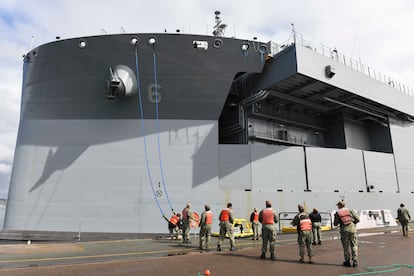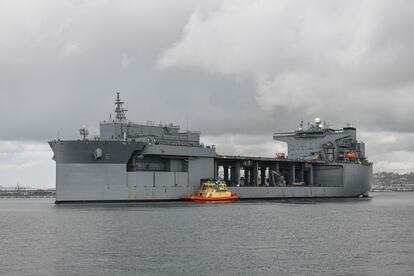Aboard the USS John L. Canley: this is how the US is reinforcing its military presence in the Pacific
The US Navy has commissioned a new ship in San Diego, which will sail as part of the Seventh Fleet. It will operate in an area of the Pacific where its great geopolitical rivals – China and Russia – are also located


When Captain Thomas Mays enters the dining room of the USS John L. Canley, he orders the group of journalists following him to take off their caps. The soldier — dressed in a camouflaged fatigue uniform — explains that, in this way, an old naval tradition is honored. Small ships didn’t have infirmaries, so sailors wounded in battle were treated and operated on in the larger spaces of the ships, which were usually dedicated to socializing.
The gesture of respect persists, even though there’s no lack of space on the Canley, an eight-level ship that has a platform consisting of almost 55,000 square feet. It’s the third-largest ship in the US Navy.
This past week, the Canley — built in San Diego, California — was added to the catalog of 291 warships belonging to the main world power. For the next 40 years, the ship — almost 800-feet-long and 165-feet-high, weighing 90,000 tons — will defend Washington’s military and economic interests in international waters. In July, she will join the Seventh Fleet, after the 350 crew members are certified for humanitarian and combat missions. Her new home will then be a tense and gigantic 48,000,000-square-mile zone of operations in the Western Pacific, where America’s most important geopolitical rivals — China, Russia and North Korea — also have a presence.
The Navy’s Seventh Fleet is made up of between 50 and 70 vessels, including submarines, about 150 aircraft and 27,000 military personnel. Defense analysts consider it likely that Washington will send two more aircraft carriers to the Western Pacific in the coming months. With three other ships already operating in the region, it would be the first time that five of the American military’s 11 aircraft carriers would be deployed in the region. This is meant to be a show of strength towards Beijing and Pyongyang.
As of mid-February, there were 104 US ships deployed around the world, a third of the total. At the beginning of October, there were eight fewer active ships, according to the Naval Institute.
“We’ll support the Marines as an attached base, [serving] as an alternative landing strip, or for whatever they need. The ship will move around the theater of war on low-intensity missions, such as aviation, mine search and special operations to support drones and other unmanned aerial vehicles,” says Commander Mays, who is originally from Texas. The military assures EL PAÍS that the Canley platform can support four helicopters landing at the same time, while being able to store another two on the deck.
A quick look at Mays’ cabin shows that the Navy has changed. A small LGBTQ+ flag hangs next to the frame of his room. The space is furnished with the basics and there are hardly any personal details. The bed is perfectly made and there are some family photos on the metal walls. In the corner, a monitor shows nine scenarios captured by video surveillance cameras. There’s also a frame with a motivational phrase: “Work like a captain.” If it weren’t for this decoration, it would be difficult to identify that this is the room of the commander of the ship.

When he’s not captaining a ship, Mays is also known as a genre author. This 28-year veteran of the US Armed Forces writes self-published niche novels, where he crosses science fiction with stories of military strategy. “Everyone who knows me knows that I love a great story. We have the opportunity to [bestow more honors] by elevating the name of John L. Canley,” Mays declares, at a ceremony with 1,600 guests. It’s the third time that he’s headed up a Navy commission.
The gigantic ship takes its name from a Black Navy sergeant born in Arkansas, who fought in the Battle of Hué, one of the longest and bloodiest of the Vietnam War. Canley was originally awarded the Navy Cross, but the military changed its mind during the Trump administration. In 2018 — 50 years later — they elevated the distinction to the highest level: the Medal of Honor. This made Canley the first African-American in the Navy to receive this award while alive.
The former military man died in May of 2022. A month later, his daughter baptized the ship by breaking a champagne bottle on the bow.
The Canley is the sixth ship of its type, an expeditionary naval base (ESB). Her design is based on crude oil tankers built by NASSCO, an American ship manufacturer. Unlike destroyers, ESBs have a support mission, expanding the capabilities of air and sea operations. The Canley’s design reflects the growing demands of a world in conflict. Other ships of this type could accommodate about 100 people, while this design doubles the capacity of the people it can carry below deck. The Canley has a hybrid crew made up of military and civilian personnel, who navigate the imposing ship.
The US Navy fell below 300 vessels 20 years ago. The fleet under Washington’s orders has remained between 270 and 300 ships since August of 2003. A Department of Defense (DOD) plan — established prior to the Biden and Trump administrations — set the goal of raising the inventory to 355 vessels. For this year, the DOD has a budget of $32.8 billion dollars set aside for the construction of nine ships, including the powerful submarine USS Columbia, which won’t be ready until 2031. Over the next 12 months, the DOD plans to retire 11 ships that have reached the end of their life. It will take about 35 years to reach 331 ships in the fleet, unless there’s a major budget increase, according to a congressional report released this past January.
Meanwhile, the Kremlin claims that it has a military force with more than 300 vessels. Other parties — such as that of the United States Naval Institute — set the true figure at 265. Last summer, President Vladimir Putin assured the public that his country would obtain 30 new ships in 2023. Beijing’s total fleet, on the other hand, is much bigger. According to a recent Pentagon report, the People’s Liberation Army Navy has 370 warships. This figure was set to reach 395 by the end of 2023 and will reach 435 by 2030.
With this in mind, the Biden administration has begun to put pressure on contractors who are currently building ships. Carlos del Toro — the secretary of the Navy — delivered a harsh message at a defense industry event held earlier this month in San Diego. “You can’t be asking for the American taxpayer to make greater public investments while you continue to goose your stock prices through stock buybacks, deferring promised capital investments, and other accounting maneuvers that — to some — seem to prioritize stock prices that drive executive compensation rather than making the needed, fundamental investments in the industrial base at a time when our nation needs us to be all ahead flank,” said the official, who was born in Havana and arrived in the United States in 1962. The Biden appointee has experience advising in boat construction through his company — SBG Technology — a government contractor.
A few days after his remarks, Del Toro presided over the commissioning ceremony of the USS John L. Canley: “Behind me is 784 feet of warfighting steel, named after an incredible warfighter. Sergeant Major. Canley’s philosophy was, ‘if today’s my day, then come get me.’ This ship is a United States ship — a warfighting ship — which may be called to sail into harm’s way one day.”
Sign up for our weekly newsletter to get more English-language news coverage from EL PAÍS USA Edition
Tu suscripción se está usando en otro dispositivo
¿Quieres añadir otro usuario a tu suscripción?
Si continúas leyendo en este dispositivo, no se podrá leer en el otro.
FlechaTu suscripción se está usando en otro dispositivo y solo puedes acceder a EL PAÍS desde un dispositivo a la vez.
Si quieres compartir tu cuenta, cambia tu suscripción a la modalidad Premium, así podrás añadir otro usuario. Cada uno accederá con su propia cuenta de email, lo que os permitirá personalizar vuestra experiencia en EL PAÍS.
¿Tienes una suscripción de empresa? Accede aquí para contratar más cuentas.
En el caso de no saber quién está usando tu cuenta, te recomendamos cambiar tu contraseña aquí.
Si decides continuar compartiendo tu cuenta, este mensaje se mostrará en tu dispositivo y en el de la otra persona que está usando tu cuenta de forma indefinida, afectando a tu experiencia de lectura. Puedes consultar aquí los términos y condiciones de la suscripción digital.
More information
Archived In
Últimas noticias
Rowan Atkinson tops Netflix at 70: ‘He’s as funny as ever’
Israeli recognition of Somaliland stirs up the Gulf
Tiger Woods turns 50: Will he continue playing on the PGA Tour or take a back seat?
The surreal journey of James Nnaji, the Barcelona youth player selected in the NBA Draft who ended up in the NCAA
Most viewed
- Oona Chaplin: ‘I told James Cameron that I was living in a treehouse and starting a permaculture project with a friend’
- Reinhard Genzel, Nobel laureate in physics: ‘One-minute videos will never give you the truth’
- Sinaloa Cartel war is taking its toll on Los Chapitos
- Why the price of coffee has skyrocketed: from Brazilian plantations to specialty coffee houses
- Chevy Chase, the beloved comedian who was a monster off camera: ‘Not everyone hated him, just the people who’ve worked with him’










































